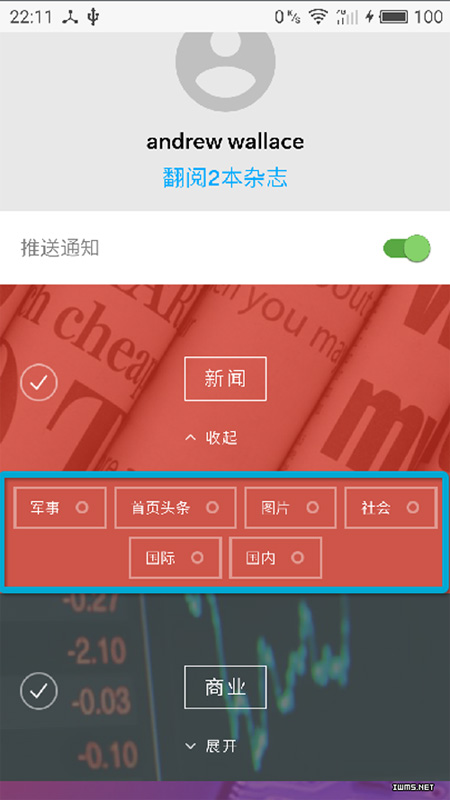жӮЁеҘҪпјҢзҷ»еҪ•еҗҺжүҚиғҪдёӢи®ўеҚ•е“ҰпјҒ
AndroidдёӯжҖҺд№ҲеҲ©з”ЁViewStubжҸҗй«ҳеёғеұҖжҖ§иғҪпјҢеҫҲеӨҡж–°жүӢеҜ№жӯӨдёҚжҳҜеҫҲжё…жҘҡпјҢдёәдәҶеё®еҠ©еӨ§е®¶и§ЈеҶіиҝҷдёӘйҡҫйўҳпјҢдёӢйқўе°Ҹзј–е°ҶдёәеӨ§е®¶иҜҰз»Ҷи®Іи§ЈпјҢжңүиҝҷж–№йқўйңҖжұӮзҡ„дәәеҸҜд»ҘжқҘеӯҰд№ дёӢпјҢеёҢжңӣдҪ иғҪжңүжүҖ收иҺ·гҖӮ
ViewStubжҳҜд»Җд№Ҳ
ViewStubжҳҜViewзҡ„еӯҗзұ»
е®ғдёҚеҸҜи§Ғ,еӨ§е°Ҹдёә0
з”ЁжқҘ延иҝҹеҠ иҪҪеёғеұҖиө„жәҗ
жіЁ,е…ідәҺStubзҡ„и§ЈйҮҠ
A stub is a small program routine that substitutes for a longer program, possibly to be loaded later or that is located remotely
еңЁJavaдёӯ,жЎ©жҳҜжҢҮз”ЁжқҘд»Јжӣҝе…іиҒ”д»Јз ҒжҲ–иҖ…жңӘе®һзҺ°д»Јз Ғзҡ„д»Јз Ғ.
ViewStubдҪҝз”ЁеңәжҷҜ

еҰӮдёҠеӣҫжүҖзӨә,
дёҖдёӘListViewеҢ…еҗ«дәҶиҜёеҰӮ ж–°й—»,е•Ҷдёҡ,科жҠҖ зӯүItem
жҜҸдёӘItemеҸҲеҢ…еҗ«дәҶеҗ„иҮӘеҜ№еә”зҡ„еӯҗиҜқйўҳ,
дҪҶжҳҜеӯҗиҜқйўҳзҡ„View(и“қиүІеҢәеҹҹ)еҸӘжңүеңЁзӮ№еҮ»еұ•ејҖжҢүй’®жүҚзңҹжӯЈйңҖиҰҒеҠ иҪҪ.
еҰӮжһңй»ҳи®ӨеҠ иҪҪеӯҗиҜқйўҳзҡ„View,еҲҷдјҡйҖ жҲҗеҶ…еӯҳзҡ„еҚ з”Ёе’ҢCPUзҡ„ж¶ҲиҖ—
жүҖд»Ҙ,иҝҷж—¶еҖҷе°ұViewStubе°ұжҙҫдёҠз”ЁеӨ„дәҶ.дҪҝз”ЁViewStubеҸҜд»Ҙ延иҝҹеҠ иҪҪеёғеұҖиө„жәҗ.
ViewStub жҖҺд№Ҳз”Ё
1.еңЁеёғеұҖж–Ү件дёӯдҪҝз”ЁViewStubж Үзӯҫ
<?xml version="1.0" encoding="utf-8"?> <RelativeLayout xmlns:android="http://schemas.android.com/apk/res/android" xmlns:tools="http://schemas.android.com/tools" android:layout_width="match_parent" android:layout_height="match_parent" android:paddingLeft="@dimen/activity_horizontal_margin" android:paddingRight="@dimen/activity_horizontal_margin" android:paddingTop="@dimen/activity_vertical_margin" android:paddingBottom="@dimen/activity_vertical_margin" tools:context="com.droidyue.viewstubsample.MainActivity"> <Button android:id="@+id/clickMe" android:text="Hello World!" android:layout_width="wrap_content" android:layout_height="wrap_content"/> <ViewStub android:id="@+id/myViewStub" android:inflatedId="@+id/myInflatedViewId" android:layout="@layout/include_merge" android:layout_width="wrap_content" android:layout_height="wrap_content" android:layout_below="@id/clickMe" /> </RelativeLayout>
2.еңЁд»Јз ҒдёӯinflateеёғеұҖ
ViewStub myViewStub = (ViewStub)findViewById(R.id.myViewStub); if (myViewStub != null) { myViewStub.inflate(); //жҲ–иҖ…жҳҜдёӢйқўзҡ„еҪўејҸеҠ иҪҪ //myViewStub.setVisibility(View.VISIBLE); }е…ідәҺViewStubзҡ„дәӢ
йҷӨдәҶ inflate ж–№жі•еӨ–,жҲ‘们иҝҳеҸҜд»Ҙи°ғз”Ё setVisibility() ж–№жі•еҠ иҪҪеёғеұҖж–Ү件
дёҖж—ҰеҠ иҪҪеёғеұҖе®ҢжҲҗеҗҺ,ViewStubдјҡд»ҺеҪ“еүҚеёғеұҖеұӮзә§дёӯеҲ йҷӨ
android:id жҢҮе®ҡViewStub ID,з”ЁдәҺжҹҘжүҫViewStubиҝӣиЎҢ延иҝҹеҠ иҪҪ
android:layout 延иҝҹеҠ иҪҪеёғеұҖзҡ„иө„жәҗid
android:inflatedId еҠ иҪҪзҡ„еёғеұҖиў«йҮҚеҶҷзҡ„id,иҝҷйҮҢдёәRelativeLayoutзҡ„id
ViewStubзҡ„дёҚи¶і
е®ҳж–№зҡ„ж–ҮжЎЈдёӯжңүиҝҷж ·дёҖж®өжҸҸиҝ°
Note: One drawback of ViewStub is that it doesn’t currently support the tag in the layouts to be inflated.
ж„ҸжҖқжҳҜViewStubдёҚж”ҜжҢҒ
е…ідәҺдёҚж”ҜжҢҒ
йӘҢиҜҒдёҖ:зӣҙжҺҘ ж Үзӯҫ
еҰӮдёӢ,жҲ‘们жңүеёғеұҖж–Ү件еҗҚдёәmerge_layout.xml
<merge xmlns:android="http://schemas.android.com/apk/res/android"> <Button android:layout_width="fill_parent" android:layout_height="wrap_content" android:text="Yes"/> <Button android:layout_width="fill_parent" android:layout_height="wrap_content" android:text="No"/> </merge>
жӣҝжҚўеҜ№еә”зҡ„ViewStubзҡ„android:layoutеұһжҖ§еҖјд№ӢеҗҺ,иҝҗиЎҢеҗҺ(зӮ№еҮ»ButtonжҢүй’®)еҫ—еҲ°дә§з”ҹдәҶеҰӮдёӢзҡ„еҙ©жәғ
E AndroidRuntime: android.view.InflateException: Binary XML file line #1: <merge /> can be used only with a valid ViewGroup root and attachToRoot=true E AndroidRuntime: at android.view.LayoutInflater.inflate(LayoutInflater.java:551) E AndroidRuntime: at android.view.LayoutInflater.inflate(LayoutInflater.java:429) E AndroidRuntime: at android.view.ViewStub.inflate(ViewStub.java:259) E AndroidRuntime: at com.droidyue.viewstubsample.MainActivity$1.onClick(MainActivity.java:20) E AndroidRuntime: at android.view.View.performClick(View.java:5697) E AndroidRuntime: at android.widget.TextView.performClick(TextView.java:10815) E AndroidRuntime: at android.view.View$PerformClick.run(View.java:22526) E AndroidRuntime: at android.os.Handler.handleCallback(Handler.java:739) E AndroidRuntime: at android.os.Handler.dispatchMessage(Handler.java:95) E AndroidRuntime: at android.os.Looper.loop(Looper.java:158) E AndroidRuntime: at android.app.ActivityThread.main(ActivityThread.java:7237) E AndroidRuntime: at java.lang.reflect.Method.invoke(Native Method) E AndroidRuntime: at com.android.internal.os.ZygoteInit$MethodAndArgsCaller.run(ZygoteInit.java:1230) E AndroidRuntime: at com.android.internal.os.ZygoteInit.main(ZygoteInit.java:1120) E AndroidRuntime: Caused by: android.view.InflateException: <merge /> can be used only with a valid ViewGroup root and attachToRoot=true E AndroidRuntime: at android.view.LayoutInflater.inflate(LayoutInflater.java:491) E AndroidRuntime: ... 13 more
еҸҜи§Ғ,зӣҙжҺҘзҡ„
йӘҢиҜҒдәҢ й—ҙжҺҘзҡ„ViewStub
дёӢйқўеёғеұҖй—ҙжҺҘдҪҝз”ЁдәҶmergeж Үзӯҫ.ж–Ү件еҗҚдёә include_merge.xml
<?xml version="1.0" encoding="utf-8"?> <LinearLayout xmlns:android="http://schemas.android.com/apk/res/android" android:orientation="vertical" android:layout_width="match_parent" android:layout_height="match_parent"> <include layout="@layout/merge_layout"/> </LinearLayout>
然еҗҺдҝ®ж”№ViewStubзҡ„ android:layout еҖј,иҝҗиЎҢ,дёҖеҲҮжӯЈеёё.
йҷӨжӯӨд№ӢеӨ–,жң¬дҫӢд№ҹйӘҢиҜҒдәҶViewStubд№ҹжҳҜеҜ№
е…ідәҺViewStubзҡ„дёҖзӮ№д»Јз Ғеү–жһҗ
inflate vs setVisibility
inflateе’ҢsetVisibilityзҡ„е…ұеҗҢзӮ№жҳҜйғҪеҸҜд»Ҙе®һзҺ°еҠ иҪҪеёғеұҖ
/** * When visibility is set to {@link #VISIBLE} or {@link #INVISIBLE}, * {@link #inflate()} is invoked and this StubbedView is replaced in its parent * by the inflated layout resource. * * @param visibility One of {@link #VISIBLE}, {@link #INVISIBLE}, or {@link #GONE}. * * @see #inflate() */ @Override public void setVisibility(int visibility) { if (mInflatedViewRef != null) { View view = mInflatedViewRef.get(); if (view != null) { view.setVisibility(visibility); } else { throw new IllegalStateException("setVisibility called on un-referenced view"); } } else { super.setVisibility(visibility); if (visibility == VISIBLE || visibility == INVISIBLE) { inflate(); } } }setVisibilityеҸӘжҳҜеңЁViewStub***次延иҝҹеҲқе§ӢеҢ–ж—¶,并且visibilityжҳҜйқһ GONE ж—¶,и°ғз”ЁдәҶ inflate ж–№жі•.
inflateжәҗз Ғ
йҖҡиҝҮйҳ…иҜ»дёӢйқўзҡ„inflateж–№жі•е®һзҺ°,жҲ‘们е°ҶжӣҙеҠ зҗҶи§Ј
android:inflatedIdзҡ„з”ЁйҖ”
ViewStubеңЁеҲқе§ӢеҢ–еҗҺд»Һи§ҶеӣҫеұӮзә§дёӯ移йҷӨ
ViewStubзҡ„layoutParametersеә”з”Ё
mInflatedViewRefйҖҡиҝҮејұеј•з”ЁеҪўејҸ,е»әз«ӢViewStubдёҺеҠ иҪҪзҡ„Viewзҡ„иҒ”зі».
/** * Inflates the layout resource identified by {@link #getLayoutResource()} * and replaces this StubbedView in its parent by the inflated layout resource. * * @return The inflated layout resource. * */ public View inflate() { final ViewParent viewParent = getParent(); if (viewParent != null && viewParent instanceof ViewGroup) { if (mLayoutResource != 0) { final ViewGroup parent = (ViewGroup) viewParent; final LayoutInflater factory = LayoutInflater.from(mContext); final View view = factory.inflate(mLayoutResource, parent, false); if (mInflatedId != NO_ID) { view.setId(mInflatedId); } final int index = parent.indexOfChild(this); parent.removeViewInLayout(this); final ViewGroup.LayoutParams layoutParams = getLayoutParams(); if (layoutParams != null) { parent.addView(view, index, layoutParams); } else { parent.addView(view, index); } mInflatedViewRef = new WeakReference<View>(view); if (mInflateListener != null) { mInflateListener.onInflate(this, view); } return view; } else { throw new IllegalArgumentException("ViewStub must have a valid layoutResource"); } } else { throw new IllegalStateException("ViewStub must have a non-null ViewGroup viewParent"); } }зңӢе®ҢдёҠиҝ°еҶ…е®№жҳҜеҗҰеҜ№жӮЁжңүеё®еҠ©е‘ўпјҹеҰӮжһңиҝҳжғіеҜ№зӣёе…ізҹҘиҜҶжңүиҝӣдёҖжӯҘзҡ„дәҶи§ЈжҲ–йҳ…иҜ»жӣҙеӨҡзӣёе…іж–Үз« пјҢиҜ·е…іжіЁдәҝйҖҹдә‘иЎҢдёҡиө„и®Ҝйў‘йҒ“пјҢж„ҹи°ўжӮЁеҜ№дәҝйҖҹдә‘зҡ„ж”ҜжҢҒгҖӮ
е…ҚиҙЈеЈ°жҳҺпјҡжң¬з«ҷеҸ‘еёғзҡ„еҶ…е®№пјҲеӣҫзүҮгҖҒи§Ҷйў‘е’Ңж–Үеӯ—пјүд»ҘеҺҹеҲӣгҖҒиҪ¬иҪҪе’ҢеҲҶдә«дёәдё»пјҢж–Үз« и§ӮзӮ№дёҚд»ЈиЎЁжң¬зҪ‘з«ҷз«ӢеңәпјҢеҰӮжһңж¶үеҸҠдҫөжқғиҜ·иҒ”зі»з«ҷй•ҝйӮ®з®ұпјҡis@yisu.comиҝӣиЎҢдёҫжҠҘпјҢ并жҸҗдҫӣзӣёе…іиҜҒжҚ®пјҢдёҖз»ҸжҹҘе®һпјҢе°Ҷз«ӢеҲ»еҲ йҷӨж¶үе«ҢдҫөжқғеҶ…е®№гҖӮ
жӮЁеҘҪпјҢзҷ»еҪ•еҗҺжүҚиғҪдёӢи®ўеҚ•е“ҰпјҒ